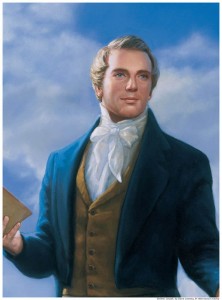On May 5, 1834, Joseph Smith led 85 men out of Kirtland, Ohio, toward Missouri. Their purpose was to help the 1,200 Saints in Missouri whose land, homes, and possessions had been taken from them by mobs. As they marched, recruits joined them. When the last group of recruits arrived, there were a little over 200 men, 12 women, and 9 children. The oldest volunteer was Samuel Baker who was 79, and the youngest was George A. Smith, Joseph Smith’s cousin; he was only 16.The men of Zion’s Camp walked the 900 mile one-way trip. They usually walked between 20 and 40 miles per day, retiring to bed late and rising early the next morning. The group always camped on Sundays, held Mormon Church meetings, and partook of the sacrament so that they could obey the commandment to keep the Sabbath day holy.
 On June 18th, the Mormon Prophet experienced a portent of danger and woke the camp early. As they marched through the city of Richmond, a woman warned them that a company of men was lying in wait for them and that they planned to kill them. The company was only able to march nine miles because of broken wagon wheels, but they were never attacked. They had intended to reach Liberty, but instead set up camp between two forks of the Fishing River. The following is what happened as recorded in Church History in the Fullness of Times on lds.org.
On June 18th, the Mormon Prophet experienced a portent of danger and woke the camp early. As they marched through the city of Richmond, a woman warned them that a company of men was lying in wait for them and that they planned to kill them. The company was only able to march nine miles because of broken wagon wheels, but they were never attacked. They had intended to reach Liberty, but instead set up camp between two forks of the Fishing River. The following is what happened as recorded in Church History in the Fullness of Times on lds.org.
Joseph learned that mobs were preparing to attack, he knelt and prayed again for divine protection. Joseph’s fears were confirmed when five armed Missourians rode into camp, cursing, and swore that the Mormons would “see hell before morning.” They boasted that nearly four hundred men had joined forces from Ray, Lafayette, Clay, and Jackson counties and were then preparing to cross the Missouri River at Williams Ferry and “utterly destroy the Mormons.” Sounds of gunfire were heard, and some of the men wanted to fight, but the Prophet promised that the Lord would protect them. He declared, “Stand still and see the salvation of God.”
A few minutes after the Missourians left, a small black cloud appeared in the clear western sky. It moved eastward, unrolling like a scroll, filling the heavens with darkness. As the first ferry load of mobbers crossed the Missouri River to the south, a sudden squall made it nearly impossible for the boat to return to pick up another load. The storm was so intense that Zion’s Camp abandoned their tents and found shelter in an old Baptist meetinghouse nearby. When Joseph Smith came in, he exclaimed, “Boys, there is some meaning to this. God is in this storm.” It was impossible for anyone to sleep, so the group sang hymns and rested on the rough benches.
One camp member recorded that “during this time the whole canopy of the wide horizon was in one complete blaze with terrifying claps of thunder.” Elsewhere the beleaguered mobbers sought any refuge they could. The furious storm broke branches from trees and destroyed crops. It soaked and made the mobbers’ ammunition useless, frightened and scattered their horses, and raised the level of the Fishing River, preventing them from attacking Zion’s Camp. The Prophet recalled, “It seemed as if the mandate of vengeance had gone forth from the God of battles, to protect His servants from the destruction of their enemies.”
Parley P. Pratt and Orson Hyde were sent to the Missouri capital to discuss the Saints’ position with Governor Daniel Dunklin. At their meeting, they were told that Governor Dunklin had decided against sending out the state militia to help the Saints, because he was afraid of starting a civil war. Pratt and Hyde returned to Zion’s camp and reported this to Joseph Smith. They knew that without the help of the state they would not be able to return the Saints to their homes.
On July 3, in a general meeting for the Missouri Saints and Zion’s Camp, the camp was disbanded, divided into smaller groups, and sent home. Joseph Smith stayed in Missouri until July 12, uplifting and helping the Saints in Missouri.
The trek was a time of trial and tribulation. Although Zion’s Camp was not able to complete their purpose or stop the hostilities and persecutions the Saints were experiencing in Missouri, Zion’s Camp was not a failure. Many of the men complained about the poor conditions, but those who pressed forward and continued in their faith that Joseph Smith was a prophet, were strengthened. The trials were for their benefit and learning. Nine of the first members of the Quorum of the Twelve Apostles were a part of Zion’s camp, and all of the members of the Quorum of the Seventy had marched with it as well. The Lord called participation in Zion’s Camp an “Abrahamic sacrifice,” and explained that the leaders in His kingdom had to be tried “as was Abraham.”